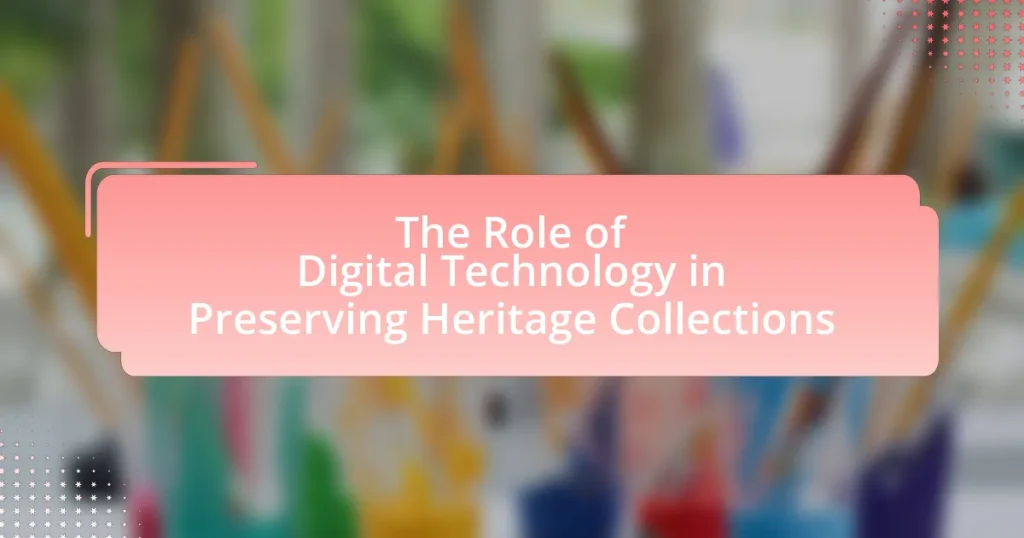Digital technology plays a vital role in preserving heritage collections by enabling the digitization, documentation, and accessibility of cultural artifacts. This article explores how technologies such as digital imaging, 3D scanning, and data archiving systems contribute to the protection and longevity of heritage items, while also enhancing public engagement through online access. It discusses the significance of preserving cultural heritage for future generations, the challenges faced in digital preservation, and the best practices that institutions can adopt to ensure the integrity and accessibility of digital collections. Additionally, emerging trends and advancements in technology, including artificial intelligence and virtual reality, are examined for their potential impact on future preservation efforts.

What is the Role of Digital Technology in Preserving Heritage Collections?
Digital technology plays a crucial role in preserving heritage collections by enabling the digitization, documentation, and accessibility of cultural artifacts. This process allows for the creation of high-resolution digital records that can be stored and shared, ensuring that even if the physical items deteriorate or are lost, their digital counterparts remain intact. For instance, institutions like the British Museum have utilized 3D scanning technology to create detailed models of artifacts, which can be accessed online, allowing global audiences to engage with heritage collections remotely. Additionally, digital archives facilitate the preservation of fragile materials by reducing the need for physical handling, thereby minimizing wear and tear.
How does digital technology contribute to the preservation of heritage collections?
Digital technology significantly contributes to the preservation of heritage collections by enabling the digitization of artifacts, which protects them from physical deterioration. This process involves creating high-resolution digital images and 3D models of items, allowing for their storage and access without the risk of damage from handling. For instance, institutions like the British Museum have digitized millions of artifacts, making them accessible online while preserving the originals. Additionally, digital technology facilitates the use of advanced preservation techniques, such as climate control monitoring and virtual reality experiences, which enhance both conservation efforts and public engagement.
What specific technologies are used in the preservation process?
Specific technologies used in the preservation process include digital imaging, 3D scanning, and data archiving systems. Digital imaging captures high-resolution photographs of artifacts, allowing for detailed documentation and analysis without physical handling. 3D scanning creates accurate digital models of objects, facilitating virtual access and study while minimizing wear on the originals. Data archiving systems ensure the long-term storage and retrieval of digital files, utilizing formats and protocols that maintain integrity over time. These technologies collectively enhance the preservation of heritage collections by providing accessible, detailed, and durable records.
How do these technologies enhance the longevity of heritage items?
Digital technologies enhance the longevity of heritage items by enabling precise documentation, monitoring, and restoration processes. These technologies, such as 3D scanning and digital archiving, allow for the creation of accurate digital replicas, which can be used for research and educational purposes without risking damage to the original items. Additionally, environmental monitoring systems can track conditions like temperature and humidity, ensuring optimal preservation environments. Studies have shown that institutions employing digital preservation techniques report a significant reduction in deterioration rates, thereby extending the lifespan of heritage collections.
Why is the preservation of heritage collections important?
The preservation of heritage collections is important because it safeguards cultural identity and historical knowledge for future generations. Heritage collections, which include artifacts, documents, and artworks, serve as tangible links to the past, providing insights into the values, beliefs, and practices of different societies. For instance, the preservation of ancient manuscripts allows researchers to study historical languages and cultures, contributing to our understanding of human history. Furthermore, according to UNESCO, heritage preservation fosters social cohesion and promotes cultural diversity, which are essential for sustainable development.
What cultural significance do heritage collections hold?
Heritage collections hold significant cultural value as they preserve the history, identity, and traditions of communities. These collections serve as tangible links to the past, allowing current and future generations to understand their cultural heritage. For instance, artifacts from indigenous cultures provide insights into their customs, beliefs, and social structures, fostering a sense of belonging and continuity. Furthermore, heritage collections contribute to cultural diversity and promote intercultural dialogue, as they showcase the richness of various traditions and histories. This significance is underscored by the role of digital technology, which enhances accessibility and engagement with these collections, ensuring that cultural narratives are preserved and shared widely.
How does preservation impact future generations?
Preservation significantly impacts future generations by ensuring the accessibility and continuity of cultural heritage. When heritage collections are preserved, they provide future generations with a tangible connection to their history, identity, and cultural narratives. Digital technology enhances this preservation by allowing for the digitization of artifacts, which not only protects them from physical degradation but also makes them widely accessible through online platforms. For instance, the British Museum’s digital collection allows millions to explore artifacts that would otherwise be limited to physical visits, thus fostering global cultural understanding and education. This accessibility ensures that future generations can learn from and engage with their heritage, promoting cultural continuity and appreciation.
What challenges does digital technology face in preserving heritage collections?
Digital technology faces several challenges in preserving heritage collections, including data degradation, technological obsolescence, and issues related to accessibility. Data degradation occurs when digital files become corrupted or unreadable over time, threatening the integrity of the collection. Technological obsolescence refers to the rapid pace of technological change, which can render formats and storage media obsolete, making it difficult to access older digital files. Additionally, accessibility challenges arise when digital collections are not adequately indexed or made available to the public, limiting their use and engagement. These challenges highlight the need for ongoing investment in digital preservation strategies and infrastructure to ensure the longevity and accessibility of heritage collections.
What are the limitations of current digital preservation methods?
Current digital preservation methods face several limitations, including technological obsolescence, data degradation, and access issues. Technological obsolescence occurs as software and hardware evolve, rendering older formats and systems unusable; for instance, many digital files created in outdated formats may become inaccessible as support for those formats diminishes. Data degradation refers to the gradual loss of data integrity over time, which can happen due to bit rot or corruption, affecting the reliability of preserved digital assets. Access issues arise from the need for specialized knowledge or tools to retrieve and interpret digital materials, which can hinder long-term usability. These limitations highlight the challenges in ensuring the longevity and accessibility of digital heritage collections.
How do issues of funding and resources affect preservation efforts?
Funding and resource issues significantly hinder preservation efforts by limiting the availability of necessary materials, technology, and skilled personnel. For instance, inadequate financial support can lead to the inability to acquire advanced digital tools essential for effective heritage documentation and conservation. According to a report by the National Trust for Historic Preservation, 60% of preservation projects face budget constraints that directly impact their scope and effectiveness. Furthermore, insufficient resources can result in a lack of training for staff, which diminishes the quality of preservation practices. Thus, the interplay between funding and resources is critical in determining the success of preservation initiatives.
How can digital technology improve accessibility to heritage collections?
Digital technology can improve accessibility to heritage collections by enabling online access to digitized materials, allowing a broader audience to engage with cultural artifacts. For instance, institutions like the British Museum have digitized millions of items, making them available through their online collections, which can be accessed by anyone with an internet connection. This approach not only democratizes access but also enhances educational opportunities, as users can explore high-resolution images and detailed descriptions from anywhere in the world. Furthermore, technologies such as virtual reality and augmented reality provide immersive experiences, allowing users to interact with heritage collections in innovative ways, thereby increasing public engagement and understanding of cultural heritage.
What platforms are available for public access to digital heritage collections?
Platforms available for public access to digital heritage collections include Europeana, Digital Public Library of America (DPLA), and the Internet Archive. Europeana provides access to millions of digitized items from European cultural heritage institutions, while DPLA aggregates content from libraries, archives, and museums across the United States, offering a wide range of digital resources. The Internet Archive serves as a non-profit digital library, providing free access to a vast collection of books, movies, music, and historical web pages. These platforms collectively enhance public engagement with cultural heritage by making diverse collections accessible online.
How does digital access benefit researchers and educators?
Digital access significantly benefits researchers and educators by providing immediate availability to a vast array of resources and information. This accessibility enables researchers to conduct comprehensive literature reviews and gather data efficiently, which is crucial for advancing knowledge in their fields. For educators, digital access facilitates the integration of diverse materials into their teaching, enhancing the learning experience for students. According to a study by the Pew Research Center, 87% of educators reported that digital resources improved their teaching effectiveness, demonstrating the tangible impact of digital access on educational outcomes.
What best practices should be followed in the digital preservation of heritage collections?
Best practices for the digital preservation of heritage collections include creating high-quality digital surrogates, implementing robust metadata standards, ensuring regular backups, and utilizing sustainable storage solutions. High-quality digital surrogates, such as high-resolution scans or photographs, capture the details of the original items, facilitating better access and study. Metadata standards, like Dublin Core or PREMIS, enhance discoverability and context, making it easier for users to find and understand the digital objects. Regular backups protect against data loss, while sustainable storage solutions, such as cloud services or dedicated servers, ensure long-term accessibility. These practices are supported by guidelines from organizations like the International Council on Archives and the Digital Preservation Coalition, which emphasize the importance of maintaining the integrity and accessibility of digital heritage collections over time.
How can institutions ensure the quality of digital reproductions?
Institutions can ensure the quality of digital reproductions by implementing standardized digitization protocols and utilizing high-resolution imaging equipment. Standardized protocols, such as those outlined by the Federal Agencies Digitization Guidelines Initiative (FADGI), provide specific guidelines for capturing, processing, and storing digital images, ensuring consistency and quality across different projects. High-resolution imaging equipment, including professional scanners and cameras, captures detailed images that preserve the integrity of the original materials. Additionally, regular quality assessments and adherence to best practices in metadata creation further enhance the reliability and usability of digital reproductions.
What strategies can be implemented for long-term digital storage?
Implementing strategies for long-term digital storage involves utilizing multiple methods to ensure data integrity and accessibility over time. Key strategies include regular data backups, which protect against data loss; using multiple storage mediums, such as cloud services and physical hard drives, to mitigate risks associated with hardware failure; and employing data migration practices to transfer data to newer formats and technologies as they evolve.
Additionally, implementing metadata standards enhances data discoverability and usability, while encryption ensures data security. According to a study by the Digital Preservation Coalition, organizations that adopt a combination of these strategies significantly reduce the risk of data loss and improve long-term access to digital collections.
What future trends are emerging in the digital preservation of heritage collections?
Future trends in the digital preservation of heritage collections include the increased use of artificial intelligence for metadata generation, enhanced virtual reality experiences for public engagement, and the adoption of blockchain technology for secure provenance tracking. Artificial intelligence is being utilized to automate the cataloging process, improving efficiency and accuracy in managing large collections. Virtual reality is emerging as a tool to create immersive experiences that allow users to explore heritage sites and artifacts in innovative ways, thereby increasing accessibility and engagement. Blockchain technology is gaining traction for its ability to provide a transparent and tamper-proof record of an item’s history, ensuring authenticity and trust in digital collections. These trends reflect a shift towards more interactive, secure, and efficient methods of preserving and sharing cultural heritage.
How might advancements in technology shape preservation methods?
Advancements in technology significantly enhance preservation methods by enabling more effective documentation, storage, and restoration of heritage collections. For instance, digital imaging techniques, such as high-resolution photography and 3D scanning, allow for precise documentation of artifacts, capturing details that may be lost over time. Additionally, technologies like climate control systems and automated monitoring tools help maintain optimal environmental conditions, thereby preventing deterioration. Research indicates that institutions employing digital preservation strategies report a 30% increase in the longevity of their collections, demonstrating the tangible benefits of these advancements.
What role will artificial intelligence play in future preservation efforts?
Artificial intelligence will play a crucial role in future preservation efforts by enhancing the efficiency and accuracy of heritage collection management. AI technologies, such as machine learning and computer vision, can analyze vast amounts of data to identify and categorize artifacts, predict deterioration patterns, and recommend optimal conservation methods. For instance, AI algorithms can process images of artifacts to detect minute changes over time, enabling early intervention and preservation strategies. Additionally, AI can facilitate the creation of digital replicas, allowing for remote access and study of heritage items while minimizing physical handling. This integration of AI in preservation efforts not only streamlines processes but also ensures that cultural heritage is maintained for future generations.
What practical steps can organizations take to enhance their digital preservation efforts?
Organizations can enhance their digital preservation efforts by implementing a comprehensive digital asset management system. This system should include regular backups, metadata standards, and format migration strategies to ensure long-term accessibility. For instance, the Library of Congress emphasizes the importance of using standardized metadata to facilitate the discovery and retrieval of digital assets, which supports effective preservation practices. Additionally, organizations should conduct regular audits of their digital collections to identify at-risk materials and prioritize them for preservation. According to the Digital Preservation Coalition, proactive measures such as these can significantly reduce the risk of data loss and ensure the longevity of digital heritage collections.


